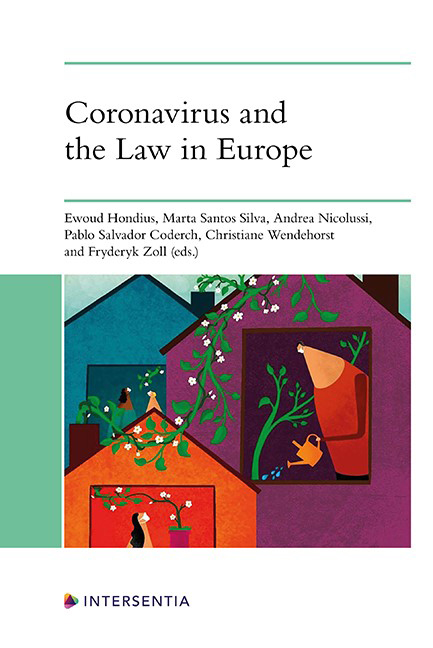Book contents
- Frontmatter
- Preface
- Contents
- List of Keywords
- List of Contributors
- PART I COVID-19 AND FUNDAMENTAL RIGHTS
- PART II STATES AGAINST THE PANDEMIC
- PART III COMPENSATION FOR COVID-19 RELATED DAMAGE
- PART IV CONTRACT LAW
- PART V CONSUMER LAW
- PART VI LABOUR AND SOCIAL LAW
- PART VII CORONAVIRUS CHANGING EUROPE
- Epilogue
- Annex: ELI Principles for the COVID-19 Crisis
- About the Editors
Who “Owns” the Data in a Coronavirus Tracing (and/or Tracking) App?
Published online by Cambridge University Press: 10 December 2021
- Frontmatter
- Preface
- Contents
- List of Keywords
- List of Contributors
- PART I COVID-19 AND FUNDAMENTAL RIGHTS
- PART II STATES AGAINST THE PANDEMIC
- PART III COMPENSATION FOR COVID-19 RELATED DAMAGE
- PART IV CONTRACT LAW
- PART V CONSUMER LAW
- PART VI LABOUR AND SOCIAL LAW
- PART VII CORONAVIRUS CHANGING EUROPE
- Epilogue
- Annex: ELI Principles for the COVID-19 Crisis
- About the Editors
Summary
To combat the spread of the COVID-19 virus, e-health has taken a sudden leap forward. Already use cases were studied to see if by means of advanced IT tools, particularly e-health applications (apps), patients could be monitored from their homes so they did not need to visit a hospital for frequent checks. The Corona pandemic gave rise to the rapid development of tracing (and/or tracking) e-health apps, which allow quickly finding the source of an infection as well as others who might have been infected because they were in the close vicinity of someone who became ill. The development and widespread use of these apps makes it even more urgent than before to answer questions regarding to whom the data gathered through such apps belong and what belonging means. Can the owner of the mobile device be considered the “owner” of the data, what does “ownership” then mean, do other stakeholders (such as health care providers, public health authorities) also have a claim to “ownership”?
INTRODUCTION: E-HEALTH AND CORONAVIRUS APPS
As might have been expected in a rapidly expanding hybrid world, in which physical reality integrates with digital and virtual reality, lockdowns and forced physical isolation to combat the COVID-19 virus have resulted in an incredibly fast changing use of Internet Technology. We suddenly find online meetings no longer a surrogate for “real” meetings and we get used to, whenever possible, working at and from home to avoid running the risk of being infected by leaving the place where you live. All at once, e-health gains momentum, as doctors experience difficulties getting in touch with their patients in hospitals. Studies have already been conducted about the use of mobile phone or tablet applications (apps) to monitor patients while at home, but these were for the most part so-called “use cases” meant to test the app and see if the results are at least comparable to actual physical meetings with a patient. Sometimes these apps have already reached the stage of accepted tools in medical care, such as apps which allow you to take a picture of your skin, send it digitally to a health service provider whose servers, supported by Artificial Intelligence, perform an algorithm based check to see if, for example, there was a possibility of skin cancer.
- Type
- Chapter
- Information
- Coronavirus and the Law in Europe , pp. 131 - 156Publisher: IntersentiaPrint publication year: 2021



